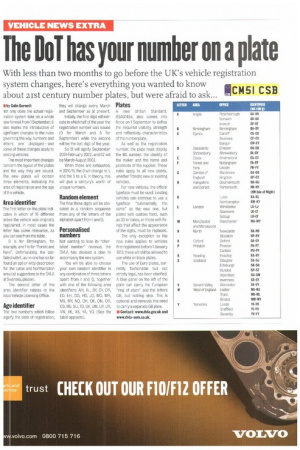The DoT has your number on a plate
Page 13

If you've noticed an error in this article please click here to report it so we can fix it.
With less than two months to go before the UK's vehicle registration system changes, here's everything you wanted to know about 21st century number plates, but were afraid to ask...
II by Colin Barnett got only does the actual regis:ration system take on a whole lew format from 1September, it also marks the introduction of significant changes to the rules loverning the way numbers and etters are displayed—and some of these changes apply to ?.xisting vehicles.
The most important changes :oncern the layout of the plates and the way they are issued. The new plates will contain three elements, indicating the area of registration and the age pf the vehicle.
Area identifier
The first letter on the plate indicates in which of 19 different areas the vehicle was originally registered. In most cases the letter has some relevance, as you can see from the table.
B is for Birmingham, for example, and F is for "Forest and Fens". Unfortunately, the plan failed with K, as no-one has so far found an apt or witty description for the Luton and Northampton area (all suggestions to the DVLA at Swansea, please).
The second letter of the area identifier relates to the local Vehicle Licensing Office.
Age identifier The two numbers which follow Signify the date of registration;
they will change every March and September as at present.
Initially, the first digit will indicate in which half of the year the registration number was issued (0 for March and 5 for September) while the second will be the last digit of the year.
So 51 will signify September 2001-February 2002, and 02 will be March-August 2002.
When these are exhausted, in 2010/11, the 0 will change to 1, and the 5 to a 6. In theory, this will give a century's worth of unique numbers.
Random element The final three digits will be allocated in a random sequence from any of the letters of the alphabet apart from land Q.
Personalised numbers Not wanting to lose its "cherished number" revenue, the DVLA has devised a plan to accompany the new system.
You will be able to choose your own random identifier in any combination of three letters apart from I and Q, together with one of the following area identifiers: AH, AL, BY, CY, DR, ED, EH, GO, HO, JO, MO, MR, MS, MY, NO, OH, OK, ON, OR, OS, RU, SU, TO, UK, UM, UP, UR, MW, XK, XS, YA, YO. (See the table opposite). Plates
A new British Standard, BSAU145d, also comes into force on 1 September to define the required visibility, strength and reflectivity characteristics of the numberplate.
As well as the registration number, the plate must display the BS number, the identity of the maker and the name and postcode of the supplier. These rules apply to all new plates, whether fitted to new or existing vehicles.
For new vehicles, the official typeface must be used. Existing vehicles can continue to use a typeface 'substantially the same" as the new one, but plates with custom fonts, such as 3D or italics, or those with fixings that affect the appearance of the digits, must be replaced.
The only exception to the new rules applies to vehicles first registered before 1January 1973; these will still be allowed to use white on black plates.
The use of Euro plates, currently fashionable but not strictly legal, has been clarified. A blue panel on the left of the plate can carry Me European "ring of stars" and the letters GB, but nothing else. This is optional and removes the need to carry a separate GB plate.
• Contact: www.dviagey.uk and www.dvia-som.co.uk.












































































































